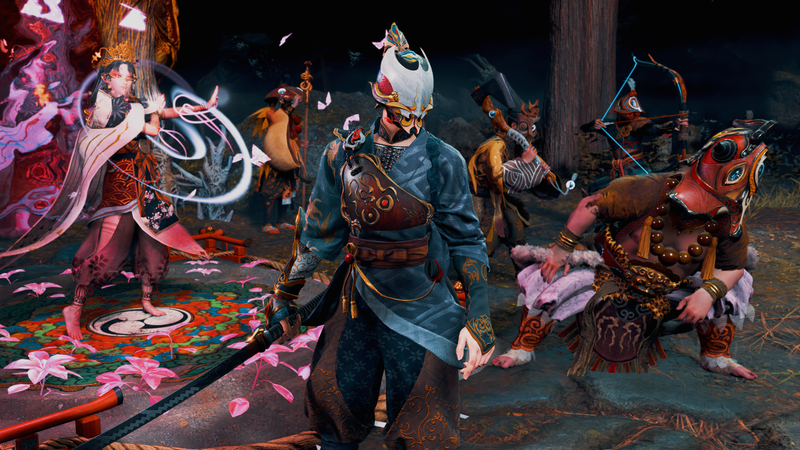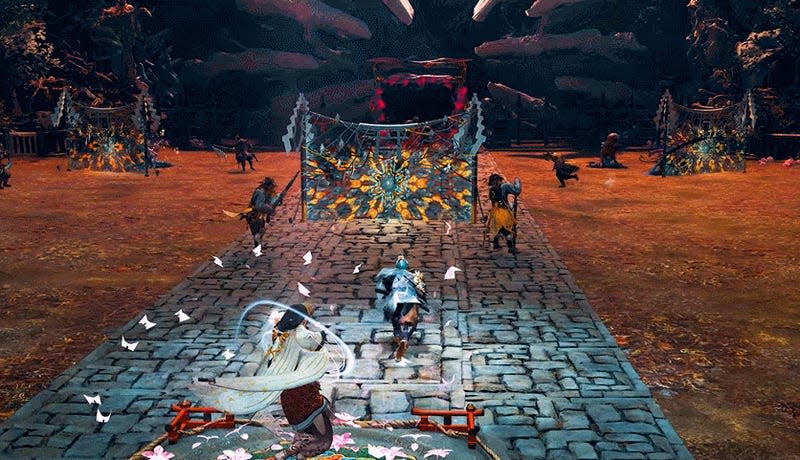Kunitsu-Gami: Path Of The Goddess Is An Incredibly Clever Strategy Mash-Up I Can't Wait To Return To

In Kunitsu-Gami: Path Of The Goddess a demon that looks like a giant stomach with a big purple tongue coming out of it appears out of a portal at night and tries to ensnare a mountain village in evil energy. I strike him down but more waves of enemies follow, each snaking along different routes to try and get to the Maiden Yoshiro whose divine powers are the only thing that can cleanse the shadows. Some village archers pick off a couple while others get stuck on a gate. Another group of conscripted locals attack with axes, slow the enemies’ advances with auras, or heal one another with medicines. It’s classic tower defense presented in a very novel way, and I have a hard time putting it down when my appointment ends.
One of several games Capcom presented at a Summer Game Fest’s adjacent Play Days event for hands-on coverage, Kunitsu-Gami: Path Of The Goddess is a mashup of horde mode strategy, action combat, and Japanese folklore presented dutifully but vibrantly across PlayStation 5, Xbox Series X/S, and PC, as well as the last-gen consoles. Made by the company’s Development Division 1, which includes the Resident Evil and Devil May Cry teams, Kunitsu-Gami is also coming to Game Pass when it launches on July 19, making it Capcom’s 2024 subscription service successor to last year’s dino shooter Exoprimal.
Unlike that one, though, Kunitsu-Gami isn’t a live-service game. Instead it’s a more traditional single-player action strategy game that revolves around cleansing a mountain of evil spirits as you, playing as the warrior Soh, guide Yoshiro across each level so she can complete a final ritual. A day-night cycle means that time is always moving when you’re not navigating menus and ordering comrades around. Players prepare for the onslaught by rescuing villagers, killing possessed animals, and collecting spirt orbs that are the game’s currency for managing recruitments, upgrades, and buildings.

When night falls monsters, called the Seethe, come out of randomly positioned gates to try to attack the Maiden and end her journey. If that happens, it’s game over. But guiding Yoshiro farther along each level requires blazing a path with your spirit orbs, expending currency that can’t be used for your defenses. The result is a clever tension between trying to get her through the level as fast as possible and trying to take your time to build up your defenses. Take too long and you might get punished for it. After each nighttime the next wave of enemies gets progressively stronger. While there’s no time limit, dawdling can cost you.
But protecting her isn’t just a matter of just positioning your limited number of class-based companions on each level and utilizing the terrain, traps, and other structures to your advantage, it’s also about combat. Following a “Dancing Swords” fighting style, Soh completes combos by linking together strong and weak attacks that increase the power of his attacks while also helping him move around the battlefield gracefully and efficiently. There’s a stamina system, a dodge roll to get out of the way of enemies’ attacks, a guard gauge that can be broken, and a special power that can be used upon building up a meter to unleash more deadly moves. It’s not full Devil May Cry, which some of the developers also worked on, but it controls crisply and feels satisfying enough that Kunitsu-Gami doesn’t suffer the normal intermittent doldrums of some other tower defense games, especially in boss fights where you have to not just worry about surviving but also finishing the fight before Yoshiro gets killed.
Where the complexity comes in, and what makes me excited to return to Kunitsu-Gami once it’s out next month, is in how varied loadouts and maps seem to get later on. As you complete levels you collect new gear that can be swapped out for certain bonuses that also come at a cost, like stronger attacks alongside taking more damage, offering the potential to give players the trade-off management of upgrades in a roguelike. You can also unlock new classes for your allies as you go, and earn resources that can be used to choose how they’re upgraded before going out into battle again. A representative from Capcom declined to comment but grinned when I asked if Soh would get to change weapon types during the game, so there might be that to look forward to as well.
As an action-strategy nerd, Kunitsu-Gami ticked all the right boxes for me. It’s impossible to know from a 30-minute demo if it can keep ramping up its complexity and challenge in an even and rewarding way across the whole game, but the slice I played showed a lot of promise.


